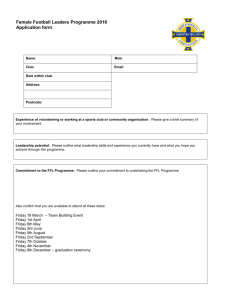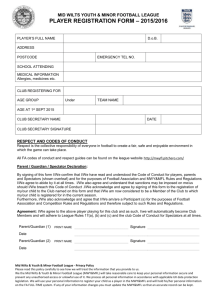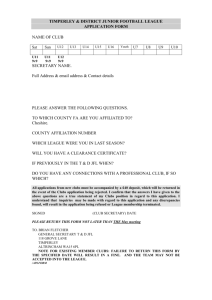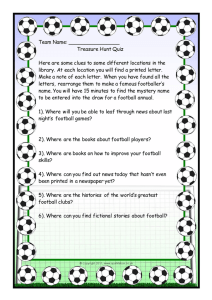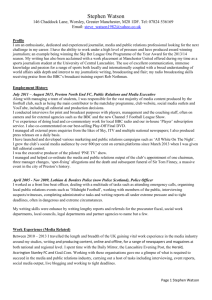'endangered species' and - Professional Historians Association
advertisement
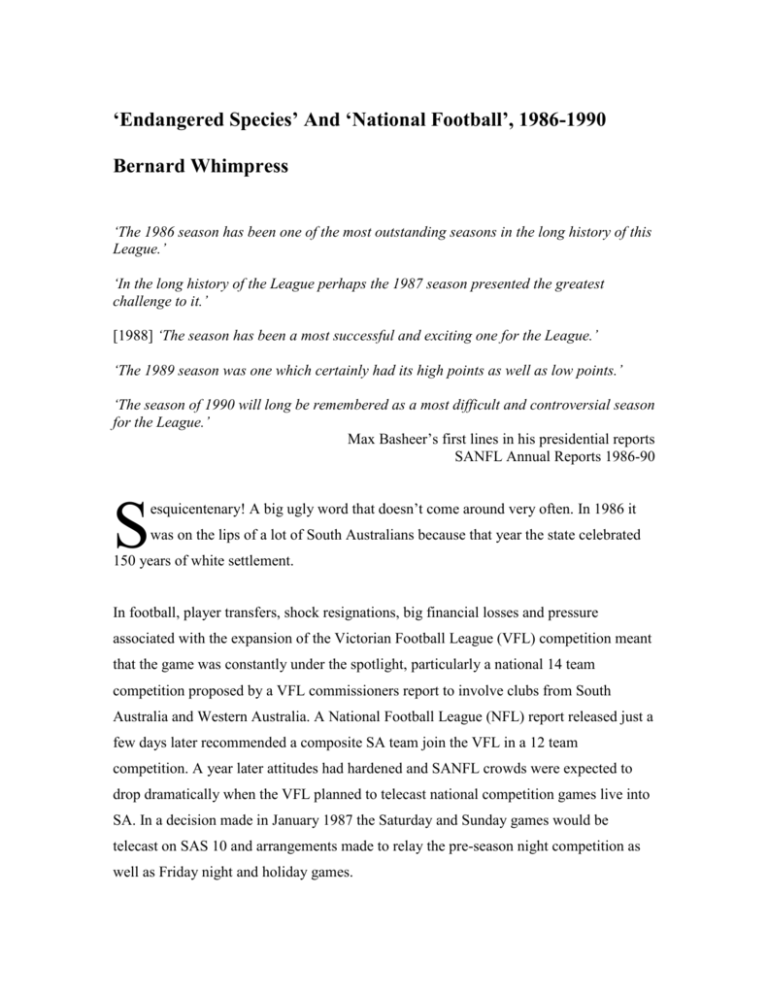
‘Endangered Species’ And ‘National Football’, 1986-1990 Bernard Whimpress ‘The 1986 season has been one of the most outstanding seasons in the long history of this League.’ ‘In the long history of the League perhaps the 1987 season presented the greatest challenge to it.’ [1988] ‘The season has been a most successful and exciting one for the League.’ ‘The 1989 season was one which certainly had its high points as well as low points.’ ‘The season of 1990 will long be remembered as a most difficult and controversial season for the League.’ Max Basheer’s first lines in his presidential reports SANFL Annual Reports 1986-90 S esquicentenary! A big ugly word that doesn’t come around very often. In 1986 it was on the lips of a lot of South Australians because that year the state celebrated 150 years of white settlement. In football, player transfers, shock resignations, big financial losses and pressure associated with the expansion of the Victorian Football League (VFL) competition meant that the game was constantly under the spotlight, particularly a national 14 team competition proposed by a VFL commissioners report to involve clubs from South Australia and Western Australia. A National Football League (NFL) report released just a few days later recommended a composite SA team join the VFL in a 12 team competition. A year later attitudes had hardened and SANFL crowds were expected to drop dramatically when the VFL planned to telecast national competition games live into SA. In a decision made in January 1987 the Saturday and Sunday games would be telecast on SAS 10 and arrangements made to relay the pre-season night competition as well as Friday night and holiday games. SANFL president Max Basheer accused the VFL of prostituting the game and stated that the telecasts would jeopardise South Australia’s entry into the national competition. In 1987 West Perth director John Clinch warned the SANFL to avoid at all costs joining the expanded VFL as the West Coast Eagles had done, stating that it would ruin SA football. The alternative view in January 1989 was that of Port Adelaide coach John Cahill who supported a VFL push to introduce an Adelaide team in its competition in 1990. The VFL national draft in 1986 was aggressive with 29 South Australian players named, many still under contract to their SANFL clubs. League president Basheer said that the draft would face legal challenges with opinion suggesting that it could be proven to be ‘anti-competitive’ under the Trade Practices Act. The maximum interstate transfer fee was increased by one third to $60 000 on 1 January 1986 following an NFL forum in Canberra. Not surprisingly the VFL wanted this fee dropped the following summer to $22 500 and offered a $500 000 distribution of cash and programs to ‘compensate’ other football bodies. Despite opposition from South Australia, Western Australia and the Australian Capital Territory, the VFL with one third of the votes muscled the weaker states to gain a 10-5 majority and dropped the fee. In 1987 there were a lot of matters up for judgement. Some observers thought that the SANFL was becoming a victim of its own history while others thought it deserved credit for not bolting into the Victorian controlled national league. The difficult thing to understand was the irony that in the early 1980s South Australia was the only state wanting a national competition and six years later it was standing firmly outside. Only a minority of football supporters realised the $4 million entry fees from the West Coast Eagles and the Brisbane Bears were a cash cow for relieving Melbourne-based VFL clubs from debt. Player moves For South Australian football the 1986 season was not one to celebrate in one respect as it began with the great migration east. Stephen Kernahan, Tony McGuinness, Craig Bradley, Peter Motley and John Platten were the biggest name players in the exodus to the VFL. Kernahan left for Carlton on a three year contract, fulfilling a six year wait for the Victorian Blues who had originally signed him as a sixteen-year-old in 1980. McGuinness also signed a three year contract with Footscray, initiating legal action from Geelong who claimed he had breached his contract with them. Carlton paid $60 000 to Port for centreman Bradley, an amount set by the NFL after the clubs disputed the amount to be paid. The biggest raiders in 1987 were fledgling club, the Brisbane Bears. South Australian players who joined them were North Adelaide’s Matthew Campbell; a strong Port Adelaide contingent in Ben Harris, former Collingwood and Port captain Mark Williams, his younger brother Stephen, and centre half back Martin Leslie; and West Adelaide captain Mark Mickan who was threatened with legal action by West. A number of SA players quickly proved themselves among the best in the VFL. Platten won the Brownlow Medal in 1987 and wingman-defender Steven Stretch, Kernahan and McGuinness won their club best and fairest awards, while in 1988 Bradley won the best and fairest award at Carlton, and Darren Kappler won Fitzroy’s top award. No doubt this brought some South Australian breast-beating but it was breast-beating from afar. The moves, of course, were not all one way. Some players came back. Magarey Medallist Kym Hodgeman returned to Glenelg after 95 games with North Melbourne and West Torrens appointed Essendon premiership defender and former Glenelg and state captain Paul Weston as captain-coach. There were also players who remained. Greg Whittlesea stayed with Sturt after receiving a handsome offer to play with Brisbane in 1987 and Glenelg’s Chris McDermott and Norwood’s Michael Aish rejected offers from the same club after previously renouncing Essendon. The offers kept coming. How would the league deal with this and other issues? Administration The league had begun to hold management seminars from the early 1980s and in 1985 representatives from all clubs discussed the game’s future direction, ground rationalisation, the tribunal system, junior development, the structure of league and club management, marketing policy and finance, including ceilings on player payments. In a long interview before the 1987 season SANFL general manager Leigh Whicker gave his views on player retention schemes, attendance figures including the effect of live telecasts of VFL games, moves towards ground rationalisation, club finances and programming. He put a brave face on player retention and the league took the matter seriously by forming a committee consisting of former deputy premier Jack Wright, AMP general manager John Potter, shadow Tourism, Recreation and Sport minister Graham Ingerson, Hardy’s Wines managing director Wayne Jackson, distinguished former player and coach Jack Oatey, former Central District president Peter Page, and Whicker himself. The idea was to assist players with career opportunities and education and stressed treating young men in a humane fashion rather than bargaining them as commodities. However, fine motives would only take matters a certain distance and talented players would seek to maximise their earnings. On the effect of live telecasts on local attendances Whicker believed people would support ‘live’ football and the local product. A ground rationalisation commission was formed to address such concerns as spectator comfort, player facilities and ground conditions. Whicker welcomed his former club Sturt’s move to Adelaide Oval and the increase in attendances which resulted. In an introduction to the 1988 season Football Times editor Ashley Hornsey wrote that there was an ‘air of confidence and optimism about’. Both the 1986 and 1987 seasons brought record financial distributions to the league clubs and attendances continued to top 1 million. In 1986 the finals series boasted a record attendance of 194 501, the Escort Cup was healthy and the rock band Dire Straits drew 50 000 fans to a concert at Football Park; while the following year saw SA claim its first national title in interstate football since 1911, and Football Park return a record profit of over $1 million. A downside was that the SANFL clubs could no longer balance their books by claiming large transfer fees from VFL clubs. They would have to work vigorously to find new ways of raising finance to help combat poaching. They also worked actively to bolster player ranks. By 1988 it was difficult to predict how much longer the league could stay out of the VFL’s extended competition. While some pundits thought the league competition appeared to be on the wane attendances were holding up and Football Park was posting record profits. With the continual player drain, however, it was difficult to see how the league could negotiate a satisfactory deal with the VFL before standards fell further. What could be learned from the Western Australian experience? South Australia had one advantage through its ownership of Football Park and an initiative aimed at making it more marketable was the creation of the Top 100 Club in 1989, a sponsorship package designed to be both attractive and commercially acceptable to the corporate sector. SA’s losses were represented by 50 players playing in the VFL in 1989 and finances were poor. Seven of the ten clubs reported financial losses: premier Port, grand finalist Glenelg, Central, North, West, Torrens and Woodville. Only Norwood, Sturt and South showed profits. The reason often given was the excessive amount spent on player payments but lavish recruiting, over-staffed clubs and falling attendances contributed. The only solutions would be paycuts for players and retrenching staff. The licence fee of $4-$6 million for entering the national competition was no longer a big issue and SA was being invited to join a corporation which would benefit from increased revenue from TV rights. By remaining outside the VFL the SANFL could go bankrupt. The SA competition was under siege because the VFL proposed taking over the NFL’s name from 1 January. The prediction was for an SA side in the national competition with a second side to follow. A further year on this seemed more likely. In 1990 the success of a pre-season trial match between Port Adelaide and Geelong at Football Park was proof of a growing impetus for the type of football that would attract big crowds. It was not a forgone conclusion, however, because the 1990 season had both ups and downs. The Foundation Cup (formerly Escort Cup) continued to be well supported and West Torrens’ decision to play its home games at Football Park was sensible. After the first two rounds 99 532 patrons had attended local league games with an astonishing 36 397 present at the Norwood–Port Adelaide Anzac Day clash at Football Park. In July the responses of hundreds of football followers to the Great AFL Debate questionnaire run by the News ‘delighted’ the league management. Among the key findings were the following: 55 per cent of respondents were against the national league; of the 55 per cent, 48 per cent stated they had no interest in the AFL and 47 per cent said the $4 million entry fee was too high; if South Australia did join the AFL 40 per cent would still regularly attend local league matches; Football followers, of course, can be fickle. Then came the setbacks. South Adelaide announced in April that it was insolvent and would close before beginning to hold merger talks. Then the AFL declined to play a State of Origin match in South Australia. Finally, the local crowds dipped away in the second half of the year to end at 949 389. While the end of season showed a financial surplus of $1 645 000 and eight out of ten clubs ended up in profit, the major event of the year was the granting of an AFL licence to the league for the Adelaide Football Club. Port Adelaide bid Without doubt the action which caused the SANFL to reverse its position and accept the AFL’s conditions of entry into a national competition was the rogue behaviour of Port Adelaide, in bidding behind its back to become the AFL’s fifteenth side. Led by gung-ho president Bruce Weber the club won praise from AFL Commission chairman Ross Oakley for the quality of its proposal but was used as a pawn by the AFL to force action by the SANFL. Its action caused a furore at the local level. Originally engineered by AFL executive commissioner Schwab on 4 July in collusion with former Port general manager Ian McKenzie the Magpies bid to join the AFL was kept secret for nearly a month, even from coach Cahill. When the news broke on 31 July North Adelaide general manager John Condon accused Port of ‘insincerity’. Later Glenelg chairman Craig McIntosh called Port’s move ‘disloyal and treacherous’ and Norwood chairman Nerio Ferraro said ‘the way Port went about undermining the fabric of SA football must be totally condemned and never forgiven’. The issue dominated newspaper headlines for most of the next month with the News playing the class card in its editorial on 1 August. Solidarity should mean something in Port Adelaide of all places … It is not the decision which is so reprehensible it is the insult. It is the way the organisers of this coup lamentably failed to take their own people into their confidence. The immediate response by the SANFL was a demand that Port drop its bid. The following day it told Port it would be thrown out of the SANFL if its bid was successful, and that it would not have its AFL games programmed at Football Park. While some observers considered the ultimatum ‘tough’ the News’ chief football writer Neville Roberts thought the league had acted weakly, expecting that Port should have been disaffiliated or suspended. The one interesting aspect was the financial revelation that Port had negotiated an entry fee of $1.5 million instead of the $4 million usually quoted. Within the Magpies itself there was also division with club stalwarts such as league director Dave Boyd admitting before an emotional meeting of 2000 members on 6 August that he had voted against its 7-1 decision to join the AFL; and Geof Motley querying president Weber whether members should have the right to view the heads of agreement deal with the AFL. However, the prevailing mood seemed to be an Us versus Them attitude and a determination to fight on. What stopped Port in its tracks was a decision by Justice Olsson in the South Australian Supreme Court to freeze the club’s AFL bid. Olsson’s decision continued an interim injunction granted at the request of Glenelg and with the support of the West Torrens and South Adelaide clubs. The most obvious outcome from the saga was the league’s entry into the AFL with the Adelaide Football Club thwarting Port’s dream. The SANFL made a surprise bid to join the national competition on 6 August when its directors voted 10-1 (Port against) in favour of a composite team thus stonewalling the Magpies. This was a payback and a way of dealing with black and white arrogance. During September Port’s bid looked to be over. Unfortunately the AFL did its own stonewalling and Port battled on. Justice Olsson’s injunction was temporary. While the SANFL had announced its intentions one of the conditions of AFL entry was dropping the court case against Port and for the league to meet Port’s legal costs. For its part Port had alleged that the injunction was a breach of the Restraint of Trade provisions of the Trade Practices Act. On the one hand economics eventually won over ethics and at the end of the season this issue might be seen to have been resolved as a draw although the fine of $8000 levied on Port by the SANFL disputes and disciplinary committee for not withdrawing its AFL bid seemed puny. Port remained, as always, conscious of the premiership struggle. For the other nine clubs it must have been a painful end to see Port raise the premiership trophy once again on grand final. Furthermore, when the season was over it must have been galling for the other clubs to hear of the Magpies gloating in their annual report: This premiership was even more meritorious because of the adverse publicity received by the Club from various sections of the public and the media brought about by the Club’s endeavours to join the A.F.L. Our only aim to join the A.F.L. was for the betterment of football in South Australia and to ensure our Club’s football future. As John Elliot might have said: ‘Pig’s arse!’ Fightback The league had done its best to maintain a viable competition. In 1986 it released a revolutionary match program with Saturday night football and an increase in doubleheader matches from four to nine, including a day/night double-header on Anzac Day. In 1989 it attempted to spread top-class football around the state with five new country centres named for the SANFL’s pre-season competition. The boldest initiative aimed at maintaining a high level of competition in Adelaide. The player retention scheme offered incentives for players to remain in SA and was successful in enticing some to do so. The scheme operated on the basis of a lump sum severance payment being made to a qualified player on retirement. The minimum qualifications for a player were to have played six league seasons in SA, including 120 league games and at least four state matches. In the first year each league club was invited to nominate two of its best players who were likely to be subjected to interstate recruitment. From the twenty nominations ten players would be assessed on their football and career future. The lottery, which had a house as first prize, generated $506 000 and provided the bulk of funds necessary to keep the best footballers. In addition companies such as Devon Homes, television station ADS 10, Continental Airlines, Australian Airlines, Graham Cornes Toyota, Hardy’s Wines, James Hardie Spicers, Coca-Cola Bottlers, Peters Ice Cream, radio stations 5DN and 5AD, and the News and Advertiser newspapers lent their support. In 1989 North and state stars Darren Jarman and Peter Bennett were accepted as special cases into the scheme requiring them to play in Adelaide for the next four years; Central forward Rudi Mandemaker turned down a $60 000 deal with the Sydney Swans; and Sturt ruckman Damian Kitschke accepted a role as a manager of a new leisure centre at Glenelg in a new dimension to the scheme. Outside the major competition the league continued its responsibilities with game development. In 1986 the most important innovation was undoubtedly the introduction of ‘Aussie Footy’ into primary schools. South Australia also hosted the Teal Cup for the first time since 1978 and established the SANFL–Nissan Scholarship Squad which consisted of players aged between sixteen and eighteen. In 1987 a three year development plan was approved with a focus on control and co-ordination of metropolitan junior football within the school sector but with support from district clubs. By 1988 an additional positive step made by the league in its development of future stars was the creation of a Country Development Squad. Media exposure was critical to the SANFL’s presentation of football. Relationships soured when radio station 5AD sought talks with the league amid speculation that the station wanted to withdraw from broadcasting the local game. 5AD had already reduced its planned coverage in 1987 to Saturday matches only, leaving 5DN and the ABC to cover Sunday and public holiday games. The same season there were also fresh threats from new media when satellite sports channel Sportsplay planned to recruit its own broadcast and commentary team to beam VFL matches live into 1000 pubs and clubs throughout Australia. Sportsplay TV Systems had won exclusive satellite rights to the VFL at a cost of $1.5 million per year for three years. It was a topsy-turvy time as in February 1987 Channel 7 seemed likely to cut its coverage of SA football and move replays from Saturday night prime time. Live coverage of reserves football and the two hour Sunday football shows had already been dropped. By November 1988, however, there were new players. Channel 9 won the rights to telecast the SANFL for the next three years, replacing Channel 10 as the only commercial station covering SA football. 5AD dropped its coverage of league football and axed its live coverage and top-rating Saturday Football Show. The clubs At the club level the picture was uncertain. Some clubs were prudently managed, others exercised caution and some found themselves in financial disarray. In 1987 Sturt made a revolutionary move towards ground rationalisation by playing its home games at Adelaide Oval for fifteen years. It would continue to train and use Unley Oval for its under-age sides. Unfortunately the move did not put money in the bank as the club recorded a loss of $134 174, the biggest deficit in its 86-year history. Central District made a record profit in 1986 of $64 000 but in so doing lost its best asset. The major reason for the surplus was the estimated minimum $100 000 transfer fee paid to the Bulldogs by Hawthorn for rover John Platten. By contrast, South Adelaide showed hesitancy with its southern expansion. It elected to stay at Adelaide Oval in 1988 despite approaches from West Adelaide and Glenelg to share Richmond and Glenelg Ovals. West Torrens adopted a radical new plan for player payments in 1987. Under a plan drawn up by coach Weston the maximum amount a player could earn was around $28 000 with a median figure of $20 000. Payments were made according to how many games they played with bonuses for wins and performances. However, the club failed the same year in its bid to take control of the management of Thebarton Oval after discussion was shelved by the West Torrens Council. Glenelg began recruiting from country districts or interstate in 1989 rather than from other league clubs. Maybe the decision was thrust upon it after an operating loss of $146 760 in 1988. Glenelg players were asked to receive a 20 per cent pay cut which would reduce the club’s deficit by $90 000. In the same year North Adelaide reported a loss of $167 889, the worst in its 96 year history and West Adelaide delayed plans on purchasing Unley Oval’s Jack Oatey Stand. The club which had only three years of its lease to run at Richmond Oval decided against the purchase until SA’s entry into the expanded VFL had been worked out. The most embarrassing circumstances for the clubs were their public appeals for funds. Sturt launched such an appeal to retain its players and buy recruits for 1988. Glenelg director Laurie Rosewarne reported that the club had raised an extra $27 000 the same season following a call on members. The good news was the SANFL announcement in 1987 that Football Park profits passed $1 million for the first time and was an increase of $100 000 on 1986. Clubs received almost $3 million from all sources – a rise of $200 000 on the previous year. At the end of 1990 the financial position of the clubs had seen some improvement with Port, Woodville, West, Sturt, South, North and Glenelg recording operating profits. Undoubtedly the club in the worst position was Torrens which lost $178 190 to push its accumulated losses to $429 812. It was little wonder that the league approved the merger of Woodville and West Torrens subject to the sale of the Torrens’ clubrooms at Thebarton Oval. For their part Glenelg and South Adelaide officials decided not to amalgamate. Glenelg president McIntosh stated the plans had been shelved and South president Ray Hendrie remarked that his club could survive in its own right. Competition 1986-90 Port Adelaide, Glenelg and North Adelaide were the competition leaders. The return of John Cahill to Port Adelaide in 1988 immediately heralded premiership success for the Magpies. Since his departure in 1982 the five year coaching reign of Russell Ebert had yielded just one grand final appearance (in 1984) and no flags. Port’s trio of wins (198890) was based on great power and stability. The key position players were Scott Hodges, Darren Smith, Mark Williams and Bruce Abernethy in the centre, Greg Phillips, Roger Delaney and Ben Harris at full-back. When ruckmen like Russell Johnston, rovers Stephen Williams and Tim Ginever, and players of the quality of Martin Leslie and a young Gavin Wanganeen (on the right half-forward flank in 1990) are weighed into the equation the Port sides of this period match up for strength, skill and adaptability with the best that have existed in the SANFL. ****** The repercussions of moving into the so-called ‘national’ football were swift and the summer of 1990-91 was perhaps the busiest on record for the South Australian game. In October 1990, for example, an interim board was named for the Adelaide Football Club. The same month the SANFL Player Retention Scheme was dismantled and 21 players were paid out. Adelaide then named Glenelg coach Graham Cornes as coach for two years. The way was cleared for Adelaide following the dropping of legal action against Port. As administrators began to think and talk nationally they also entered a new era by forming the SA Football Commission which became the most powerful body controlling football in the state. The Sharks was the name favoured by league officials for the AFL’s newest club and it continued to be bandied around for several weeks. By November, however, the Crows was adopted and the emblem included a shield with a black crow emblazoned across the face. The colours were those long used by state sporting teams of navy blue, red and yellow. By December the club secured some of the best seats at Football Park, directly opposite the main grandstand, and in January the Toyota Motor Company was named club sponsor through its Camry vehicle. Toyota and its dealers formed a consortium to co-sponsor the Camry Crows for three years at a reputed cost of $1 million. With 41 000 fans watching the Crows defeat Essendon in a trial game in February they were advised to buy a season’s ticket to be sure of seats to watch their club. As the new season approached Adelaide elected its first board. A voice left croaking in the wilderness was that of Port president Weber whose business Budget and Maintenance Contracting Pty Ltd had been wound up in September. Weber also found himself nominated for a Wilkie award by the eastern-state journalist Keith Dunstan’s Anti-Football League as the person who had done least for the game in the past year. While there was talk of Port merging with Fitzroy as the Port Adelaide Lions based at Adelaide Oval in 1992 this came to nothing and Weber’s confirmation in February that the Magpies would make a fresh bid to join the AFL would be several years coming to fruition.
